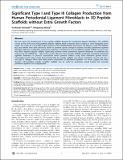Significant Type I and Type III Collagen Production from Human Periodontal Ligament Fibroblasts in 3D Peptide Scaffolds without Extra Growth Factors
Author(s)
Kumada, Yoshiyuki; Zhang, Shuguang
DownloadKumada-2010-Significant type I a.pdf (3.343Mb)
PUBLISHER_CC
Publisher with Creative Commons License
Creative Commons Attribution
Terms of use
Metadata
Show full item recordAbstract
We here report the development of two peptide scaffolds designed for periodontal ligament fibroblasts. The scaffolds consist of one of the pure self-assembling peptide scaffolds RADA16 through direct coupling to short biologically active motifs. The motifs are 2-unit RGD binding sequence PRG (PRGDSGYRGDS) and laminin cell adhesion motif PDS (PDSGR). RGD and laminin have been previously shown to promote specific biological activities including periodontal ligament fibroblasts adhesion, proliferation and protein production. Compared to the pure RADA16 peptide scaffold, we here show that these designer peptide scaffolds significantly promote human periodontal ligament fibroblasts to proliferate and migrate into the scaffolds (for ~300 µm/two weeks). Moreover these peptide scaffolds significantly stimulated periodontal ligament fibroblasts to produce extracellular matrix proteins without using extra additional growth factors. Immunofluorescent images clearly demonstrated that the peptide scaffolds were almost completely covered with type I and type III collagens which were main protein components of periodontal ligament. Our results suggest that these designer self-assembling peptide nanofiber scaffolds may be useful for promoting wound healing and especially periodontal ligament tissue regeneration.
Date issued
2010-04Department
Massachusetts Institute of Technology. Center for Biomedical EngineeringJournal
PLoS ONE
Publisher
Public Library of Science
Citation
Kumada, Yoshiyuki, and Shuguang Zhang. “Significant Type I and Type III Collagen Production from Human Periodontal Ligament Fibroblasts in 3D Peptide Scaffolds without Extra Growth Factors.” PLoS ONE 5.4 (2010): e10305.
Version: Final published version
ISSN
1932-6203